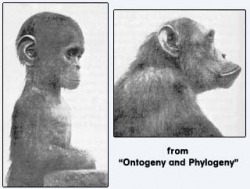Homo sapiens, the eternal learner

There are numerous physical characteristics that a scientist can use to distinguish a human from another primate of similar appearance. Noticeable differences include the capacity for bipedalism, a scarcity of body hair, and a lack of opposable toes. But there is one other characteristic that was arguably the ultimate driving force behind its evolution as a species. Humans have big brains. Really big brains. These brains are so big, in fact, that in order to fit through the birth canal, human babies emerge before they are fully developed. Human adults are very morphologically similar to chimpanzee infants. Scientists call this phenomenon "neoteny". As Andrew Lehman summarizes, "Ancestor infant features prolong or extend themselves over the course of evolution into later and later maturational phases until infant traits appear in the adults of descendants." (What is neoteny?). This evolutionary adaptation has extraordinary effects on a very unique physiological capacity of the human species. Humans have the ability to learn through the entirety of their lifetimes. According to the Franklin Institute Resources for Science Learning website, "The human brain is able to continually adapt and rewire itself. Even in old age, it can grow new neurons." (The Human Brain). How does the growth of new neurons relate to learning ability?
The concept of learning is mysterious, and has remained an enigma throughout history. It has been thoroughly researched and heavily contemplated throughout history. Recent studies propose a mechanism, called Long Term Potentiation, which would explain this ability. This is discussed in the Biological Understanding of Learning section. Essentially, this frames learning as a repetition of electrical impulses through a neural extension called an axon through a synapse by way of a chemical messaging system involving molecules called neurotransmitters. The growth of new neurons in the brain relates to this process in that, as Professor John Kimball of Harvard University explains, "[Neurons] arise from a pool of stem cells in the brain, and newly-formed neurons are particularly sensitive to the induction of LTP." (Learning, Memory, and Long Term Potentiation). In other words, newly specialized neurons are able to produce synaptic junctions very readily, and these junctions are especially capable of Long Term Potentiation.
But learning is far more specialized than this relatively simplistic model would suggest. Different people learn in different ways, and prefer different methods. These methods may be categorized differently depending on the source, but the three most widely accepted categorizations are those of visual/spatial learning, auditory learning, and kinesthetic/tactile learning. There are significant differences between these three styles, and these will be discussed in the Learning Styles section. Further specified categorizations with relevance to the topic will also be considered. The main focus of the topic regards the influence behind this specialization of preferred learning styles. The relative contribution of both nature and nurture regarding learning will be considered. Some vehemently suggest that cultural differences have a profound affect on preferred learning styles while others would state this as a fatal fallacy. If culture is not the major factor influencing these differences, then what else might explain them? What recent research has found is a potentially groundbreaking discovery that might permanently change the way learning is understood.
The concept of learning is mysterious, and has remained an enigma throughout history. It has been thoroughly researched and heavily contemplated throughout history. Recent studies propose a mechanism, called Long Term Potentiation, which would explain this ability. This is discussed in the Biological Understanding of Learning section. Essentially, this frames learning as a repetition of electrical impulses through a neural extension called an axon through a synapse by way of a chemical messaging system involving molecules called neurotransmitters. The growth of new neurons in the brain relates to this process in that, as Professor John Kimball of Harvard University explains, "[Neurons] arise from a pool of stem cells in the brain, and newly-formed neurons are particularly sensitive to the induction of LTP." (Learning, Memory, and Long Term Potentiation). In other words, newly specialized neurons are able to produce synaptic junctions very readily, and these junctions are especially capable of Long Term Potentiation.
But learning is far more specialized than this relatively simplistic model would suggest. Different people learn in different ways, and prefer different methods. These methods may be categorized differently depending on the source, but the three most widely accepted categorizations are those of visual/spatial learning, auditory learning, and kinesthetic/tactile learning. There are significant differences between these three styles, and these will be discussed in the Learning Styles section. Further specified categorizations with relevance to the topic will also be considered. The main focus of the topic regards the influence behind this specialization of preferred learning styles. The relative contribution of both nature and nurture regarding learning will be considered. Some vehemently suggest that cultural differences have a profound affect on preferred learning styles while others would state this as a fatal fallacy. If culture is not the major factor influencing these differences, then what else might explain them? What recent research has found is a potentially groundbreaking discovery that might permanently change the way learning is understood.
